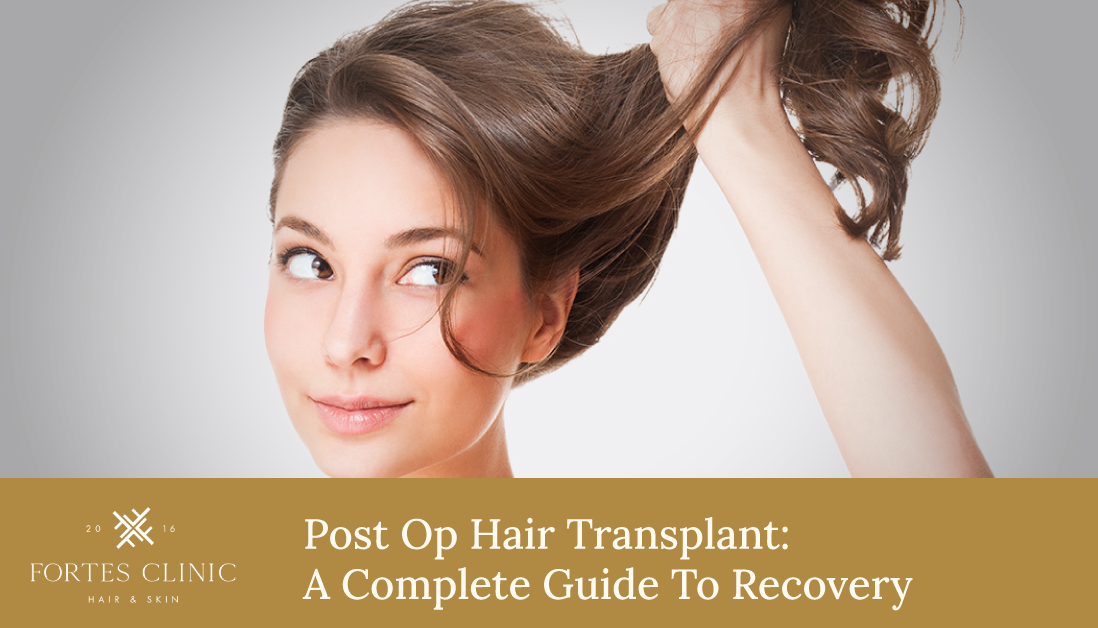Understanding Post-Op Hair Transplant
Hair transplant surgery can be a transformative experience for those seeking to restore a fuller head of hair and regain confidence in their appearance. However, the journey to achieving optimal results doesn’t end once the surgery is complete. Understanding the post-op hair transplant care and recovery process is essential for ensuring the success of your hair transplant. In this comprehensive guide, we’ll walk you through everything you need to know about recovering from a hair transplant surgery.
The Procedure: What Happens During a Hair Transplant Surgery
Before delving into the recovery process, it’s crucial to understand what happens during a hair transplant surgery. Typically, there are two primary methods: Follicular Unit Transplantation (FUT) and Follicular Unit Extraction (FUE). During FUT, a strip of hair-bearing skin is removed from the donor area and dissected into individual grafts for transplantation. In contrast, FUE involves extracting individual follicular units directly from the donor area using a punch tool. Once the grafts are prepared, they are meticulously implanted into the recipient area, following the natural hair growth pattern.
What to Expect Post-op Hair Transplant
After the surgery, it’s normal to experience some discomfort, swelling, and minor bleeding in the donor and recipient areas. Your scalp may also feel tender and tight. Additionally, you may notice tiny scabs forming around the transplanted grafts, which will eventually shed within a few days. It’s essential to follow your surgeon’s post-operative instructions carefully to promote healing and minimise the risk of complications.
Immediate Post-Op Hair Transplant Care
Bandaging and Dressing
Your surgeon will apply bandages or dressings to the donor and recipient areas immediately after the surgery. These dressings help protect the grafts and minimise the risk of infection. It’s crucial to keep the bandages clean and dry as instructed by your surgeon.
Pain Management
You may experience some discomfort or pain following the surgery. Your surgeon will prescribe pain medication to help alleviate any discomfort. It’s essential to take the medication as directed and avoid aspirin or ibuprofen, as these can increase the risk of bleeding.
Medication Instructions
In addition to pain medication, your surgeon may prescribe antibiotics to prevent infection and corticosteroids to reduce swelling. It’s essential to take all prescribed medications as directed and follow up with your surgeon if you experience any adverse reactions.
Managing Swelling and Discomfort Post-op Hair Transplant
Ice Packs and Cold Compresses
Applying ice packs or cold compresses to the swollen areas can help reduce swelling and alleviate discomfort. Be sure to wrap the ice packs in a cloth to prevent direct contact with your skin and limit each session to 10-15 minutes.
Proper Head Elevation Post-op Hair Transplant
Elevating your head while sleeping can also help reduce swelling. Use extra pillows or a reclining chair to keep your head elevated at a 45-degree angle.
Avoiding Strenuous Activities
It’s essential to avoid strenuous activities, such as heavy lifting or vigorous exercise, for at least the first week following surgery. These activities can increase blood pressure and potentially disrupt the healing process.
Wound Care and Hygiene Post-op Hair Transplant
Cleaning Instructions for the Transplanted Area
Your surgeon will provide specific instructions on how to clean the transplanted area. Typically, this involves gently washing the scalp with a mild shampoo and water. Avoid rubbing or scrubbing the scalp vigorously, as this can dislodge the grafts.
Shampooing and Washing Techniques Post-op Hair Transplant
After the initial few days, you can gradually increase the intensity of your shampooing and washing techniques. Use lukewarm water and gentle motions to cleanse the scalp, being careful not to disturb the grafts.
Avoiding Irritants and Sun Exposure
It’s essential to avoid exposure to irritants such as cigarette smoke and harsh chemicals, as these can irritate the scalp and delay healing. Additionally, protect your scalp from direct sun exposure by wearing a hat or applying sunscreen with a high SPF.
Diet and Nutrition for Optimal Recovery Post-op Hair Transplant
Importance of a Balanced Diet
A balanced diet rich in vitamins, minerals, and protein is essential for promoting healing and supporting healthy hair growth. Focus on incorporating plenty of fruits, vegetables, lean proteins, and whole grains into your diet.
Foods That Promote Healing
Certain foods are particularly beneficial for promoting healing and supporting hair growth, including salmon, eggs, nuts, spinach, and avocados. Consider incorporating these foods into your meals to enhance your recovery process.
Hydration and Its Role in Post-op Hair Transplant Recovery
Staying hydrated is crucial for overall health and wellbeing, as well as promoting optimal healing. Be sure to drink plenty of water throughout the day to keep your body hydrated and support the healing process.
Timeline of Recovery Post-op Hair Transplant
Immediate Post-op Phase (Days 1-7)
During the first week following surgery, focus on resting and allowing your body to heal. Follow your surgeon’s post-operative instructions carefully and avoid activities that may disrupt the healing process.
Early Recovery Phase (Weeks 1-2)
2 weeks post-hair transplant, you may begin to resume light activities, such as walking and gentle stretching. Continue to monitor your progress and follow up with your surgeon as needed.
Intermediate Recovery Phase (Weeks 3-6)
By the third week, most of the swelling and discomfort should subside, and the transplanted grafts will start to take root. It’s essential to continue following your surgeon’s instructions and avoid any activities that may put undue stress on the scalp.
Long-Term Recovery Phase (Months 3-12)
6 months after a hair transplant, you’ll start to notice significant improvements in the appearance of your hair as the transplanted follicles continue to grow. Be patient and continue to follow up with your surgeon for monitoring and adjustments as needed.
Managing Post-op Hair Transplant Symptoms and Complications
Itching and Tingling Sensations
It’s common to experience itching and tingling sensations as the scalp heals. Avoid scratching or rubbing the scalp, as this can damage the grafts. Your surgeon may recommend using a gentle moisturiser to soothe the itching.
Dealing with Numbness or Tightness Post-op Hair Transplant
Some degree of numbness or tightness in the scalp is normal following surgery and should gradually improve over time. If you experience persistent numbness or tightness, be sure to discuss it with your surgeon.
Addressing Infection or Excessive Bleeding
While rare, infection or excessive bleeding can occur following surgery. If you notice signs of infection, such as increased redness, swelling, or drainage from the incision sites, contact your surgeon immediately.
Follow-Up Visits and Consultations
Importance of Follow-Up Appointments
Follow-up appointments with your surgeon are essential for monitoring your progress and addressing any concerns or complications that may arise. Be sure to attend all scheduled appointments and follow your surgeon’s recommendations for ongoing care.
Assessing Progress and Adjustments
During follow-up visits, your surgeon will assess the progress of your healing and may make adjustments to your treatment plan as needed. It’s essential to communicate openly with your surgeon and discuss any questions or concerns you may have.
Discussing Future Treatment Plans
Depending on your individual goals and the results of your hair transplant, you may discuss future treatment plans with your surgeon. This may include additional hair transplant procedures, as well as non-surgical options such as medication or laser therapy.
Emotional and Psychological Support
Coping with Changes in Appearance
Undergoing a hair transplant surgery can have a significant impact on your self-esteem and body image. It’s essential to be patient with yourself and allow time to adjust to any changes in your appearance. Surround yourself with supportive friends and family members who can offer encouragement and reassurance.
Support Networks and Resources
Joining support groups or online forums for individuals who have undergone hair transplant surgery can provide valuable emotional support and practical advice. Connecting with others who have had similar experiences can help you feel less alone in your journey.
Setting Realistic Expectations for Results
While a hair transplant can produce dramatic improvements in your appearance, it’s essential to have realistic expectations for the results. Hair growth is a gradual process, and it may take several months to see the full effects of the surgery. Trust in the expertise of your surgeon and be patient as you await the final outcome.
Embracing Your Hair Transplant Journey
Recovering from a hair transplant surgery requires patience, diligence, and a commitment to following your surgeon’s instructions. By taking proper care of your scalp and prioritising your overall health and wellbeing, you can maximise the success of your surgery and enjoy long-lasting results. Remember, your hair transplant journey is a journey towards greater confidence and self-assurance. Embrace it with positivity and optimism, knowing that you’re taking proactive steps towards achieving the appearance you desire.



